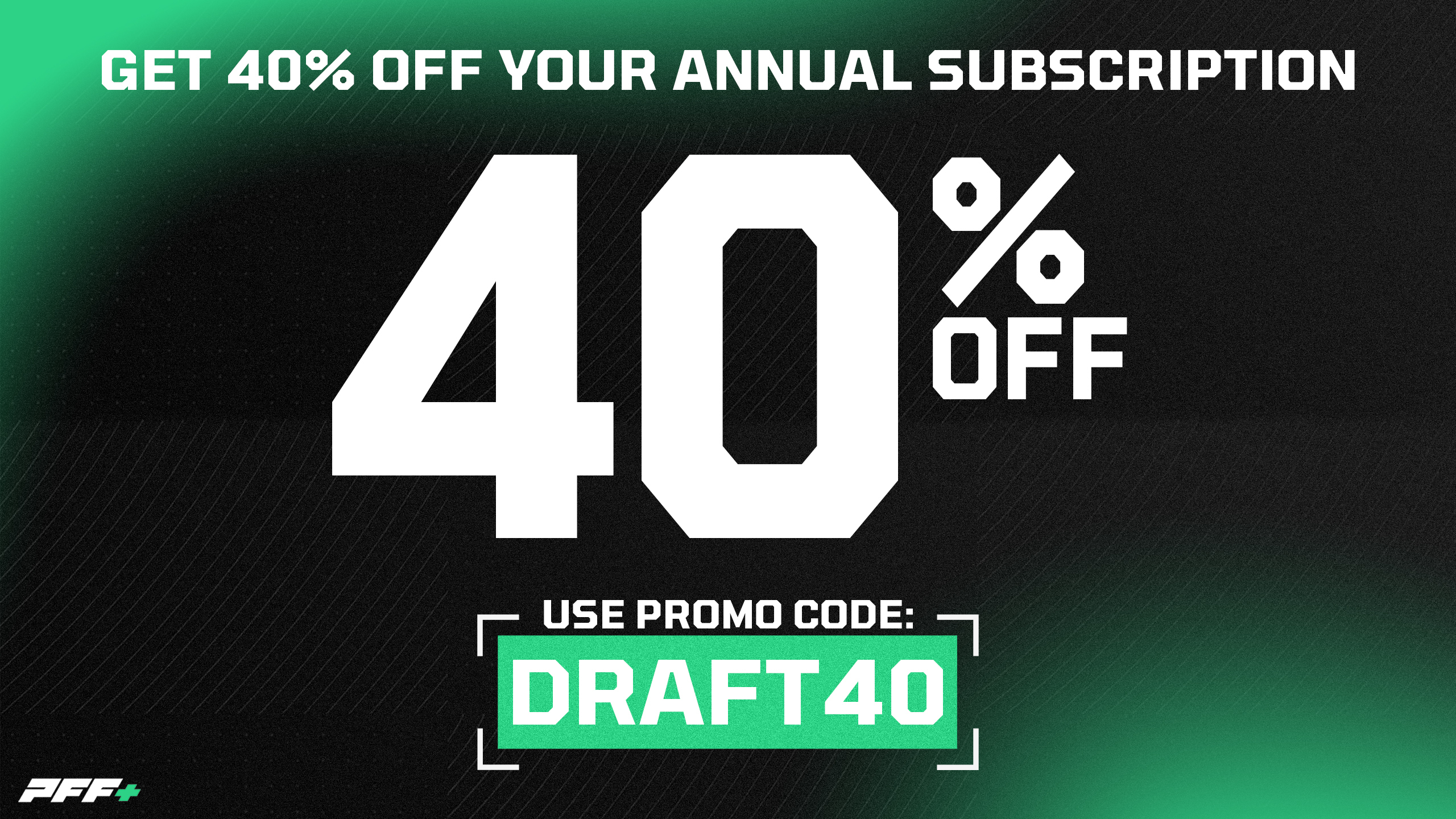- How contracts can affect trades: Contracts are an underrated consideration of draft trades in the first round.
- Fifth-year option value: Fifth-year options are wildly different under new rules and may be a bit overvalued
- Trade cost: NFL teams are more open to trades than ever, what is the cost to buy a draft pick?
Estimated reading time: 9 minutes
Seeing where the top prospects land, the surprise risers and fallers, and the shocking trades that shake up the entire draft are the far more exciting components of next weekend’s festivities. Nevertheless, after the 2023 NFL Draft has concluded, the business of football once again takes focus.
Due to the advent of the rookie wage scale in 2011, the draft's entire calculus changed — for smart teams, at least — as positional value, fifth-year option considerations, a new valuation of draft picks for trades and many more considerations came into play. We wanted to walk through some of the contractual considerations that play a pivotal role behind the scenes as all 259 draft picks officially sign the dotted line on their rookie contracts over the next few months.
How much cap space do teams need to sign their picks?
This is one of the common misconceptions with adding a rookie class to a roster, as people add up the first-year cap hits for each pick and drop that onto the pre-existing cap space number. In reality, each team is usually carrying well over 51 players during the offseason. I say 51 because before roster cutdowns, each team technically only has to account for the 51 largest total cap hits on their roster, plus some other minor expenses we won’t get into here. So, when the team signs their draft picks, they aren’t adding the full amount of that player’s Year 1 cap hit onto the books, but rather replacing a player at the bottom of the roster.
For example, the New England Patriots currently have 11 total draft picks, with their cumulative 2023 cap hits expected to equal around $12-13 million. However, only three of them are expected to replace current players on the top 51, and these new additions would only take up about $2.5 million in additional 2023 cap space.
Are the contracts for each pick completely fixed?
The rookie wage scale is not quite as exact as some may think. The four-year values of the contract are relatively set, though there is a small range to negotiate, and many of the contract terms are battled over each year from May through August.
First-round contract values
Another underappreciated aspect of the rookie wage scale is just how steep the decline is from the very top. When the Chicago Bears traded down from No. 1 overall to No. 9, they didn’t just move eight spots in the draft, they also nearly chopped the value of their first pick in half from around $40 million to around $23 million.
The exponential decline looks even starker through this lens: The No. 1 overall pick will receive about a $26.5 – $27 million signing bonus — which is more than Chicago’s pick at No. 9 will earn over the entirety of his four-year rookie contract. The 31st overall pick will sign for about one-quarter of what the No. 1 overall pick receives, and then things flatten a bit, with the 100th pick receiving about one-eighth of the No. 1 overall value. This is another consideration with positional value at the very top of the draft and is the inspiration for the idea of the “Winner’s Curse.”
For the first time in 2022, every first-round pick had the entirety of their contract fully guaranteed. That quickly falls off, with the No. 36 overall pick from 2022 in New York Jets running back Breece Hall receiving no guaranteed money beyond the third year while no pick after No. 47 overall earned even a single dollar of guaranteed salary in the third year of their contract.
How valuable is it really to have the fifth-year option?
Before we dive into this question, it’s important to note that fifth-year options from 2011-17 are different from fifth-year options for the 2018 draft class and beyond. Prior to the new NFL CBA, fifth-year options were tied to draft slots, with picks 1-10 earning a higher value than 11-32, and they were only guaranteed for injury at exercise.
Now, the No. 1 pick through the No. 32 pick can earn one of four values tied to their position and performance through the first three seasons, and the options are fully guaranteed the moment they are exercised. With the 2018 draft class, we saw No. 1 overall pick quarterback Baker Mayfield earn an $18.858 million option, whereas No. 32 overall pick quarterback Lamar Jackson earned an option worth $23.016 million.
We eventually saw the Cleveland Browns do whatever they could to get out from paying the full amount of that option, ultimately paying $10.5 million to facilitate a trade to the Carolina Panthers while recouping a fifth-round pick. So, if your later pick in the first round pans out there is no longer a discount associated with finding a better player down the board, and if you exercise the option but wanted to move on from a healthy player after the fourth season, you’d be on the hook for the entire option amount.
From 2011-17, 138 out of 223 options were exercised (61.9%), which is not a bad hit rate. In our two-year sample under the new rules, 41 out of 64 (64%) have been exercised, with the 2020 draft class' decisions due Monday, May 1st right after this year’s draft. However, from 2011-2018, of the 159 options exercised, 62 of those players did not go on to sign a second contract with the club (39%). So, there’s about a three-in-five chance an option gets exercised, and of that pool, another three-in-five chance it leads to a second multi-year contract.
We may place too much value on the fifth-year option for a few reasons. There is undoubtedly value in an extra year of cost control on a talented young player, but many of the top players will get extended regardless, with quarterbacks almost always pushing for an extension after Year 3 as if they were a non-first-rounder anyway (teams can still benefit from the fifth-year option serving as a placeholder that gets folded in as new money, however). But this past offseason illustrated how to navigate the potential downside effect of declining the option, and then having the player break out in Year 4.
The New York Giants extended quarterback Daniel Jones and the Atlanta Falcons extended tackle Kaleb McGary after declining their fifth-year options, and they didn’t even have to place the franchise tag. The Las Vegas Raiders declined an $8.034 million fifth-year option on running back Josh Jacobs and had to pay him just $2 million more with a $10.091 million franchise tag. Ideal? No. Crippling? Certainly not.
The Houston Texans are the only team from 2011-19 to exercise the option on all first-round picks, whereas the Seattle Seahawks are the only team to exercise none of them. It should be noted for both clubs that they made fewer than nine first-round selections over the span, as Houston had eight first-round picks and Seattle had five first-round picks.
Long story short, they are a useful mechanism, but with the new rules they may not be the new rules in place they may not be nearly as valuable as before.
How much are draft picks worth in cash?
This is a fun question and we’ve added many more data points to help us answer it over the last few years, with a sharp increase in “salary dump” trades, which are far more common in leagues like the NBA. NFL teams have become more amenable to the idea, where veteran players are moved and the incumbent club effectively buys a draft pick — or a higher draft pick — in exchange for retaining salary. There are two buckets these trades tend to fall into:
- A player has guaranteed salary remaining that a team will be forced to pay even if they cut the player, so they trade a player along with a draft pick or agree to retain a portion of the salary to “buy” a draft pick from another team. This is a true salary dump, which was what we saw this week with wide receiver Allen Robinson moving from the Los Angeles Rams to the Pittsburgh Steelers.
| Year |
Player |
Position |
Trading team |
Acquiring team |
Draft picks added |
Cash inherited |
| 2017 | Brock Osweiler | QB | Houston Texans | Cleveland Browns | 2nd & 6th | $16M |
| 2019 | Aqib Talib | CB | Los Angeles Rams | Miami Dolphins | 5th | $4.2M |
| 2023 | Allen Robinson | WR | Los Angeles Rams | Pittsburgh Steelers | Swap of 7ths | $5M |
Brock Osweiler remains the truest salary dump we’ve ever seen, with the Browns inheriting the entirety of his $16 million guaranteed compensation and sending a 2017 fourth-round pick for a 2017 sixth- and 2018 second-round pick. That 2018 second-round pick turned into running back Nick Chubb. Cleveland effectively turned Chubb’s four-year, $7.38 million rookie contract into a four-year, $23.38 million contract, which he still comfortably outplayed despite the running back position’s recent devaluation by the league.
- A player may have too large a salary for an interested team to inherit, and/or the selling team would like to maximize their return, so they agree to retain salary to receive maximum draft pick compensation. This is more of a win-win proposition where saving money matters more to the acquiring team, and adding draft capital at the expense of cash matters more to the selling team. Recent examples include the Chicago Bears trading linebacker Roquan Smith to the Baltimore Ravens and edge defender Robert Quinn to the Philadelphia Eagles at last year’s trade deadline.
| Year | Player | Position | Trading team | Acquiring team | Draft picks added | Cash retained |
| 2019 | Ryan Tannehill | QB | Miami Dolphins | Tennessee Titans | 4th | $5M |
| 2021 | Von Miller | ED | Denver Broncos | Los Angeles Rams | 2nd & 3rd | $9M |
| 2022 | Roquan Smith | LB | Chicago Bears | Baltimore Ravens | 2nd & 5th | $4.8M |
| 2022 | Robert Quinn | ED | Chicago Bears | Philadelphia Eagles | 4th | $7.1M |
The Chicago Bears realized they weren’t going to retain either player in 2023, so they acquired three top 150 picks at the deadline. Smith carried value regardless, but the No. 133 overall pick from Philadelphia was effectively bought for $7 million, and why not if you were in Chicago’s position.


